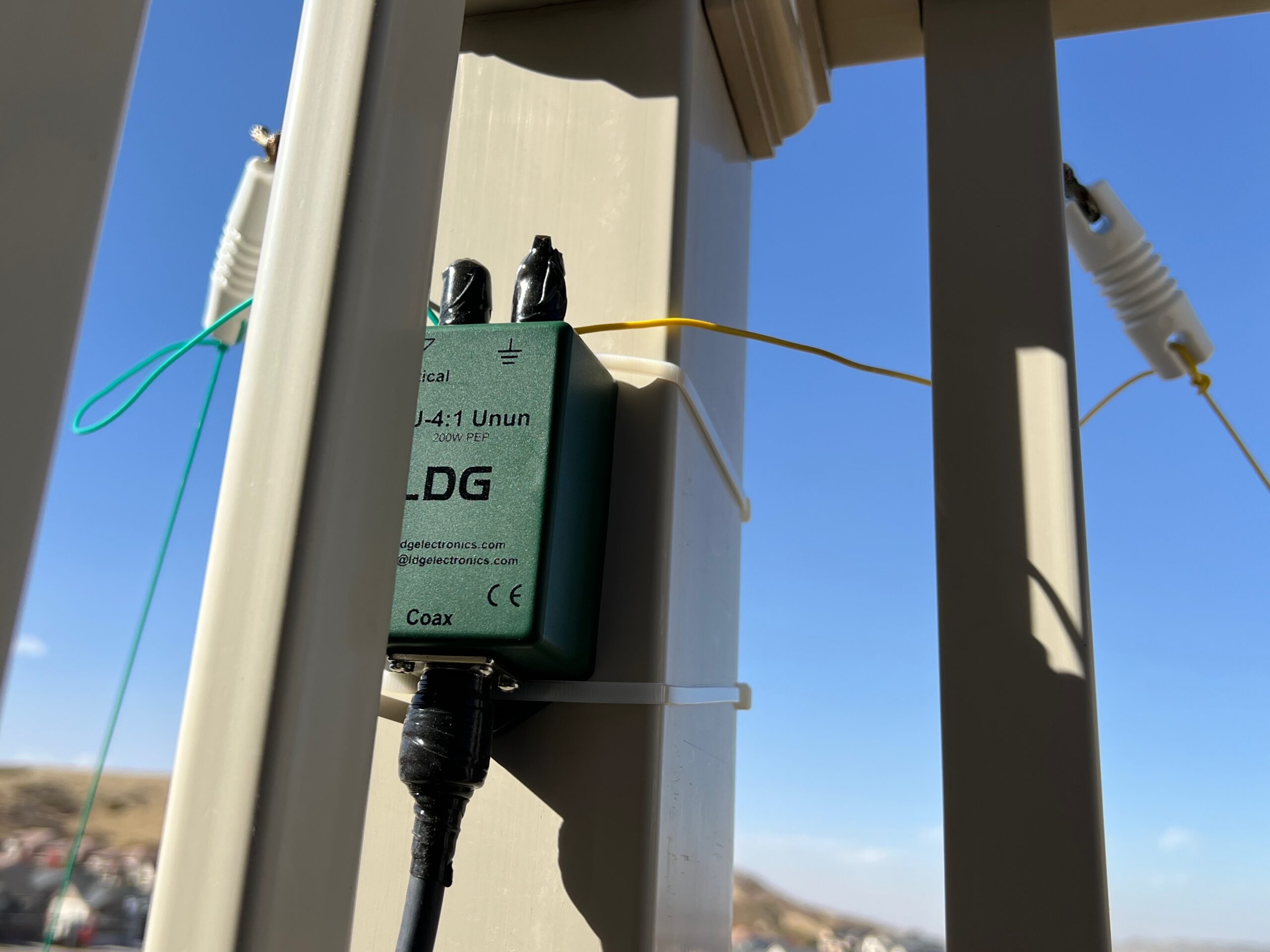My “re-entry” into ham radio has been a real journey, and a whirlwind, as I described recently. Part of that has been going from thinking I couldn’t possibly participate in HF (shortwave) bands at all, to coming-up with a stealth vertical I call my “radontenna,” and now, to being interested in experimenting a bit with things. That experimentation has led to some interesting insights.
To be sure, living in an area with an HOA (homeowner’s association) with a (very) long list of rules is the bane of many a ham radio operator these days. I don’t know about the rest of the world, but in the United States, unless the neighborhood is fairly old, it’s becoming impossible to find a detached home that isn’t overseen by an HOA. In any case, it’s something I have to deal with (or choose to move elsewhere, I suppose, but that’s a decision for another day).
HOAs have led amateur radio operators to get very creative when it comes to antenna design, and to accept a lot of compromises in the process — which is exactly how the radontenna came-up. (I’ll write a separate article on that soon.) While the radontenna works, I nevertheless wanted to experiment with some other options to see if I could cure some of the shortcomings of not just the radontenna specifically, but of the characteristics of vertical antennas more generally.
Working predominantly FT8 and FT4 digital modes since my return to ham radio, I’ve been able to use the PSK Reporter website and their valuable functionality to gain some general insights into how well my antenna is doing its job. Of course, it’s impossible to know how much of that is the antenna itself, and how much is band conditions either enhanced or cursed by solar activity, etc. But nevertheless, I could visibly see gaps in coverage, and limitations in terms of “reach.” That was the motivator to want to see if I could augment and enhance my options a bit.
Setting-up my MFJ EFHW antenna at home (I’d purchased it specifically for Parks on the Air and field use more generally) gave me some expectation that I could change the situation a bit with a wire antenna. And running comparatively low power (I’ve yet to even run my Icom IC-7000 transceiver at its full power of 100 watts), playing around with simple wire antennas using comparatively light 20 gauge stranded wire was fairly inexpensive and easy to do. So, off I went.
What I Wanted: A Dipole
While I knew I wanted a wire antenna for my experimenting, what I also specifically wanted was some sort of dipole, or a play on the dipole. The problem is how to get it high enough and still be center-fed. Remember: This thing needs to be as stealthy as possible, lest I raise the ire of the HOA lords, so erecting masts of any kind was completely out of the question.
The only practical place to give the antenna some elevation was on a rail post of the deck off of an upstairs bedroom, but that deck is not in the middle of the back of the house. Out of necessity, then, I needed to go asymmetrical, which brought me to the off-center-fed (or OCF) dipole.
Even considering optimizing the antenna length was off the table for all the reasons I’ve already mentioned; I just wanted as much wire as I could get in the space available. Measuring from the deck rail post closest to center, to each of the property corners, I found that the west leg would be about 53 feet (16.15m), and the right leg 35 feet (10.66m). Unfortunately, my spools of wire were 50 feet long, so the west leg ended-up being a little over 50 feet (15.24m). So, that’d be the dimensions of it.
I should note that it forms an inverted vee. The angle between the legs is fairly wide, I’m guessing about 120° or so. Each end has to attach to a low fence, and is just a few feet off the ground; again, I have no choice in that matter.
The build itself was easy enough; just some dog bone insulators for good measure, polyester rope to tether the ends, and of course, I decided to use an affordable LDG 4:1 unun at the feed point rather than wind my own. (By the time you buy the supplies and the shipping to get them, the economics don’t really add-up in every case, including mine.)
I purchased and put in-place the rather long RG8X coax feed from my basement shack, out the side of the house, around, up to the upper deck, and to the unun; I opted for a premade 100 foot (30m) cable.
The Naysaying
If nothing else is true about amateur radio, it’s that there are numerous, rather lively (to put it nicely) opinions about every aspect of the hobby. Whether it’s FT8 being the best thing to happen to ham radio is ages, to FT8 destroying everything ham radio stands for; to the waiver of CW requirements for licensing destroying the hobby, to the waiver of CW requirements blowing open the doors to let people in and save it all from collapse… ham radio seems to reflect the current culture where everyone has an opinion, and everyone thinks they’re entitled to express it… Loudly. And, right in the face of anyone who disagrees.
So, from the noise of amateur radio, I already knew:
- LDG baluns and ununs suck because their quality is sh*t. Or, LDG baluns and ununs are great.
- OCF dipoles are basically outdoor dummy loads. Or, OCF dipoles are a great antenna choice.
- The ends of the dipole legs should be at least 10 feet (3m) off the ground or it won’t work. Or, it really doesn’t matter how the legs are tethered.
- It’s absolutely critical to get the leg lengths perfect. Or, close enough is good enough if you use an antenna tuner.
- Vertical antennas are noisy, so my dipole would automatically be better. Or, vertical antennas are not noisy, and I wouldn’t see any benefit from a dipole.
- Long coax cable runs ruin everything. Or, “I have a 200 foot run, it’s just fine.”
- OCF dipoles are just a common mode current generator. Or, use a choke and you’re fine.
In short, from all that, I was assured of one thing: I’d have to find out for myself how my particular antenna worked in my particular situation, and whether it provided any benefit. So, let the assessment begin.
The Results
The first attempt at using my new OCF dipole, it empirically sounded to my ears like the receive gain was better than my radontenna vertical. I decided to do a few A/B comparisons. I did this with the stuff at-hand, and it’s not scientific. I did the following:
- Connected one of the antennas.
- Did the auto-tuning process 4 kHz off of the FT8 frequency on the tested band.
- Tuned back to the FT8 frequency, and listened to the signals across a few transmit cycles, taking an average “S” reading as shown on my Icom IC-7000’s digital meter.
- Changed the antenna, and repeated the steps.
Much to my extreme surprise, the OCF dipole showed a whopping two “S” units of better gain. That equates to 12db as I understand it. I’m not convinced that I believe the difference is that dramatic, and I intend to repeat the tests additional times, at different times of the day, and on a greater range of bands. But regardless, there’s a noticeable improvement in receive gain.
I don’t have a way to scientifically (or unscientifically) evaluate noise levels, but regardless, the noise level on the radontenna vertical is without question higher than it is with the OCF dipole, which was observable when doing the A/B comparisons for receive gain. As I’ve used the vertical, it seems to me to have gotten noisier over time — or I’m just sensitive to it. But for certain, the dipole is simply quieter. Between that, and the overall gain improvement, it’s a pretty incredible and demonstrable result. Whether this “proves” the common belief among some that verticals are always noisier, I can’t say. But in my specific case? Seems to be.
Assessing things like radiation pattern and transmit gain improvements is impossible with the gear I have available to me, but empirically, I see improvements there, too. Given the nature of how FT8/FT4 and PSK Reporter actually work, I recognize that there are a huge number of variables. But in the past few days, my PSK Reporter plots are showing improved “reach” with good signal reports to Europe, Asia/Pacific, and to a lesser degree, to South America. On the first day of using the dipole, I went from fewer than 50 entities to well over 60 entities worked from the DXCC list, which was a pretty big jump in a single day.
Again, it’s all empirical evidence, but the results seem pretty clear to me: The OCF dipole is doing a demonstrably better job than my radontenna vertical.
Where to From Here
So, where does this leave me, exactly? Well, I suppose if a neighbor complains about seeing a couple of thin wires running from the upper deck to the property corners, or one of the HOA enforcement people gets in touch, I’ll have to deal with that, and my only recourse is return to the radontenna. But that’s going to have to happen anyway once the summer months return, as the legs of the dipole are physically in the way of things like lawn mowing.
But in the meantime, it’s nice to have an antenna that’s providing me with more options, more QSOs, more DX, and more fun. And, come summer, there’s always POTA activations to keep me busy, right?

